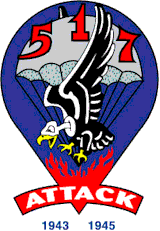 Dick Spencer is the creator of the Battling Buzzards logo |
517th Parachute Regimental Combat Team |
 |
 Dick Spencer is the creator of the Battling Buzzards logo |
517th Parachute Regimental Combat Team |
 |
The following is an excerpt from the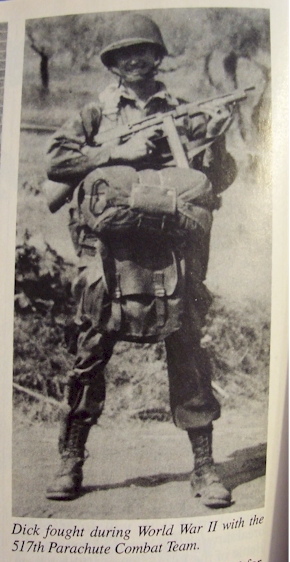 Western Horseman Magazine’s staff written
as part of an article on Dick’s death. (photos added by webmaster)
Western Horseman Magazine’s staff written
as part of an article on Dick’s death. (photos added by webmaster)
Dick graduated from University of Iowa in December 1942, and immediately went
into the infantry Officer Candidate School at Fort Benning, Georgia. Later in
1943, as a second lieutenant, Dick was sent to parachute jump training school.
While he was at Camp Toccoa, he married Jo Nicholson, whom he had known since
high school. He served with distinction in World War II with the 517 Parachute
Combat Team. The unit sailed for Italy in May 1944 and was committed to action
north of the bomb-battered port of Civitavecchi. the 517th was bloodied in a
decisive battle before being pulled from the lines, reassembled, and air-dropped
from C-47s at night into south France. Its mission – to block German
reinforcements from reaching the Allied beachhead on the southern coast at
St-Tropez. in this campaign, Dick’s outfit saw 94 days of combat that pitted the
517th against an enemy entrenched in pillboxes and other fortifications snaking
down from the Maritime Alps.
There was a period of rest after the campaign in southern France before the unit
was moved north by rail to Soissons, the site of a World War I battlefield.
Plans for a Christmas holiday were aborted with von Rundstedt’s breakthrough
that became known as the Battle of the Bulge. The 517th action in the battle was
significant, but primarily of interest to the professional military men. His
third battalion was assigned the objective of taking the Belgian village of
Manhay, a cluster of houses at an important crossroads held by the 2nd SS
Panzer, the Nazi unit responsible for the atrocities at Malmedy. On December 27,
1944, supported by a barrage of 8,600 shells from 15 massed artillery
battalions, Dick’s outfit attacked across the snowfields surrounding the
village. the Germans counterattacked with their armor, including captured
American Sherman tanks. The fighting that followed was a savage hammer and tongs
battle, but by 0330 hours, the village crossroads had been secured. The 517th’s
success at Manhay denied the Germans a route north via Liege to the vital port
city of Antwerp – von Rundstedt’s objective.
The paratroopers of the 517th would soon be involved in two difficult river crossings, including the Roer in the vicinity of the Hurtgen Forest. The Roer was defended by one of Hitler’s crack parachute outfits that had been preparing fortifications for 6 weeks. Dick’s outfit continually attacked until the united captured its sector on the east bank of the river. When Germany surrendered, Dick came home with the Bronze Star with two clusters and two Purple Hearts. The 517th was soon deactivated, but its members still reflect the old esprit de corps by holding reunions. Dick was discharged from the Army in September 1945, and he headed for Des Moines to be with his wife and baby daughter whom Dick had never seen.
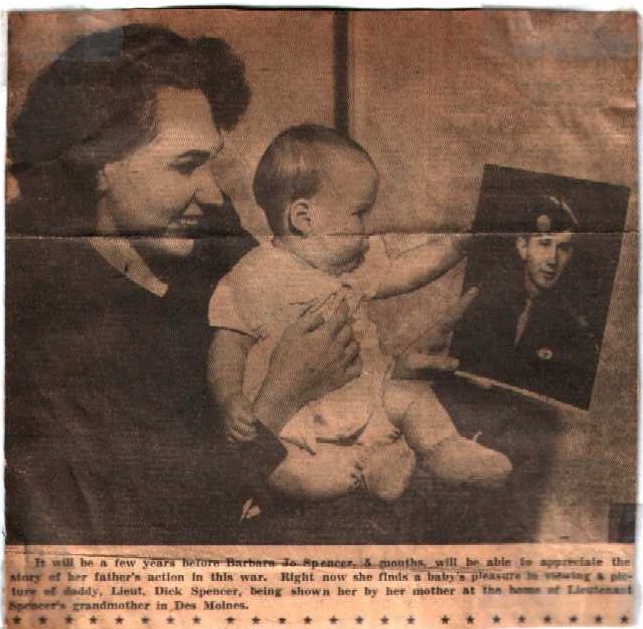
He went to work for Look Magazines in their Des Moines office, as a commercial office. A couple years later, he worked for Steinel Publications, on three statewide police publications, then went back to Look. He wasn’t there long before he took the job as managing editor of the information service for the University of Iowa. He also taught a new course – editorial cartooning – and wrote the first textbook on this subject.
|
From the University of Iowa website "A Bird in the Hand" |
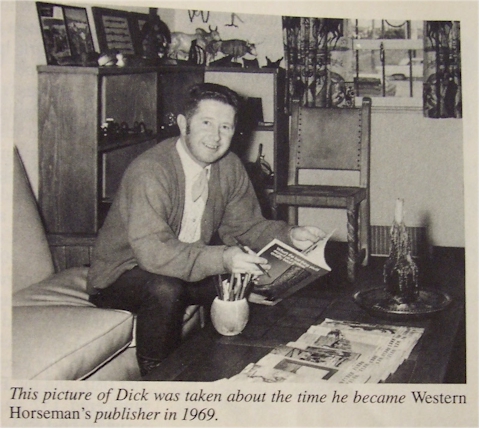
He was director of publications for the University of Colorado when Western Horseman publisher Don Flint offered him the job of editor at the magazine. Under Dick’s guidance the magazine grew and prospered. It gained worldwide respect as the leader in its field. He helped with the formation and support of the Cowboy Artists of America. He went on horseback trail rides all over the nation. Dick played a major role in gaining support for the fledgling Appaloosa horse Club when he was editor of Western Horseman. Like his father, Dick developed an abiding interest in Indian lore and culture. He adopted the name of Pony Tracks, learned to speak several Indian tongues, and learn sign language. He enjoyed anything to do with the outdoors. he liked scuba-diving, snorkeling, hunt and fishing, skiing, snowshoeing, flying. Dick will always be remembered for his humor. One fan said, “Telling Dick Spencer a joke he hasn’t heard is the equivalent of killing four bulls in Madrid.”
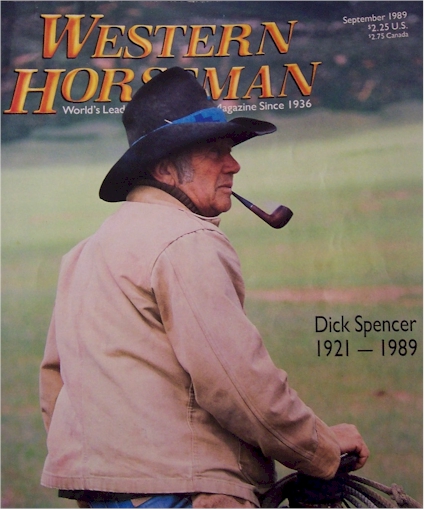
Dick was preceded in death by his son, Rick. His wife of 40 years still lives in Colorado, as do his two daughters Bobbi Jo and Debbie.
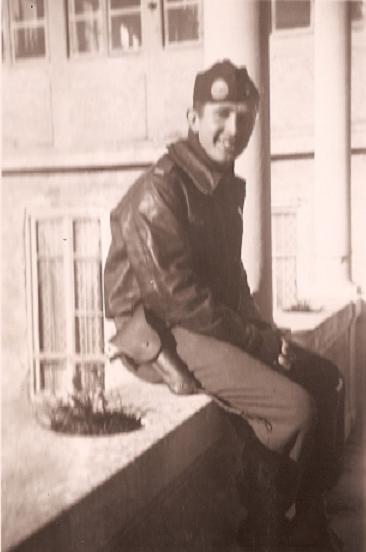
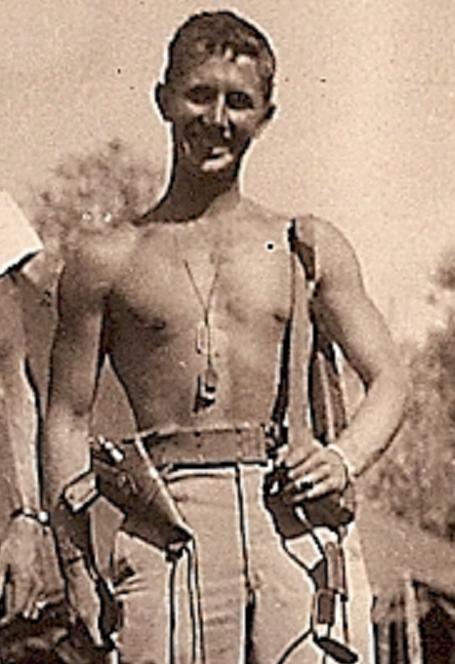
HQ Co. 3rd Battalion Officers
Huertgen Forest, January 1945Standing: Lt Col Forest Paxton, Major Robert McMahon, Capt Grant Hooper,bottom Lt. Dick Spencer, Lt. Howard Hensleigh
|
Back row: Lt. Dick Spencer, Lt. Irving Pinkston, Lt. O.G. Garrett, Lt. Howard Hensleigh, Lt. Steve Maciag 1st row: Lt. McKillop, Lt. Hilliard B. Thomas ( KIA Col De Braus), Lt. Edward Athey This picture was taken in the olive orchard near Frascati, Italy not too long before we took off for the jump into France. - Howard Hensleigh |
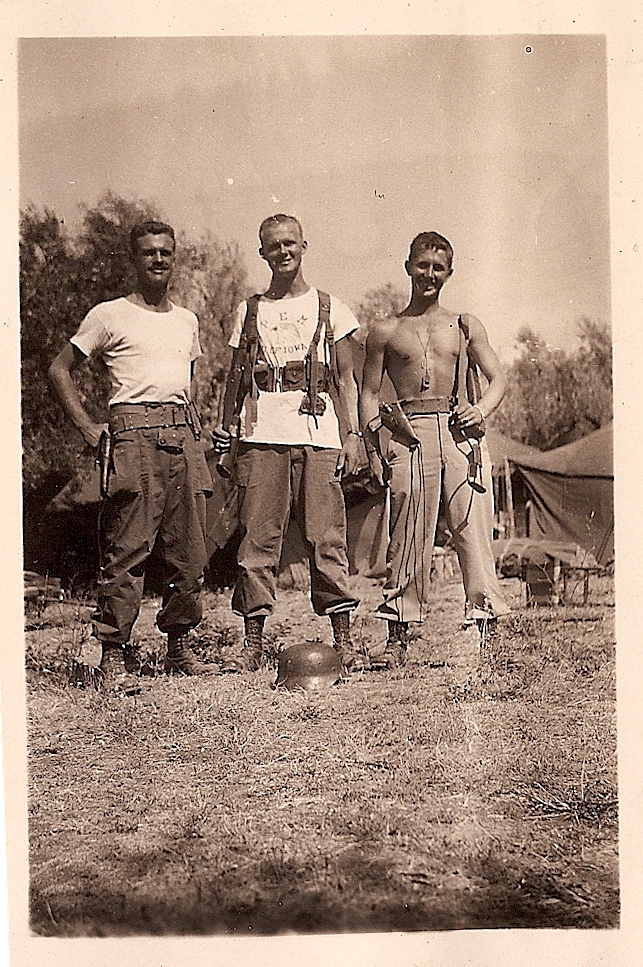 Irv Pinkston, Howard Hensleigh, and Dick Spencer Notice the Iowa PEM (Physical Education) shirt on Howard |
From Google Books:
Pulitzer prize cartoons: the men and their masterpieces
by Richard Spencer -
Art - 1951 - 125 pages |
Editorial cartooning
by Richard Spencer -
Caricatures and cartoons - 1949 - 110 pages
Snippet view -
About this book
|